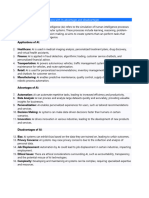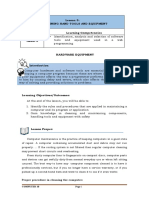0% found this document useful (0 votes)
59 views3 pagesArtificial Intelligence Worksheet
The document is a revision worksheet on Artificial Intelligence, covering objective and subjective questions about AI concepts, applications, and ethical considerations. It discusses the AI project cycle, including stages like problem scoping, data exploration, model building, and deployment. Additionally, it highlights the roles of AI in various sectors such as healthcare and entertainment, and emphasizes the importance of ethics and transparency in AI systems.
Uploaded by
ishalkezeketharaCopyright
© © All Rights Reserved
We take content rights seriously. If you suspect this is your content, claim it here.
Available Formats
Download as PDF, TXT or read online on Scribd
0% found this document useful (0 votes)
59 views3 pagesArtificial Intelligence Worksheet
The document is a revision worksheet on Artificial Intelligence, covering objective and subjective questions about AI concepts, applications, and ethical considerations. It discusses the AI project cycle, including stages like problem scoping, data exploration, model building, and deployment. Additionally, it highlights the roles of AI in various sectors such as healthcare and entertainment, and emphasizes the importance of ethics and transparency in AI systems.
Uploaded by
ishalkezeketharaCopyright
© © All Rights Reserved
We take content rights seriously. If you suspect this is your content, claim it here.
Available Formats
Download as PDF, TXT or read online on Scribd
/ 3















































































